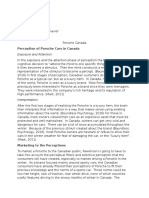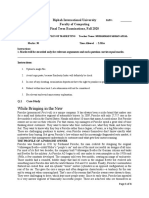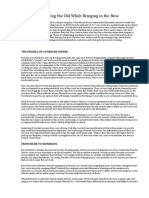0 ratings0% found this document useful (0 votes)
Automotive Industry Segmentation - Case Study
Automotive Industry Segmentation - Case Study
Uploaded by
nghuyen2603The automotive industry has approximately 23 segments according to J.D. Power and Associates. Porsche competes in several of these segments with models like the 911, Boxster, Cayman, Cayenne, Macan, and 918 Spyder. Porsche segments its markets based on descriptive elements like demographics and behavioral elements like brand responses. It targets specific segments like younger buyers and more female buyers to expand its customer base through campaigns featuring everyday use and spokespeople like Maria Sharapova.
Copyright:
© All Rights Reserved
Available Formats
Download as DOCX, PDF, TXT or read online from Scribd
Download as docx, pdf, or txt
Automotive Industry Segmentation - Case Study
Automotive Industry Segmentation - Case Study
Uploaded by
nghuyen26030 ratings0% found this document useful (0 votes)
The automotive industry has approximately 23 segments according to J.D. Power and Associates. Porsche competes in several of these segments with models like the 911, Boxster, Cayman, Cayenne, Macan, and 918 Spyder. Porsche segments its markets based on descriptive elements like demographics and behavioral elements like brand responses. It targets specific segments like younger buyers and more female buyers to expand its customer base through campaigns featuring everyday use and spokespeople like Maria Sharapova.
Original Description:
auto motice
Original Title
Automotive Industry Segmentation - case study (1)
Copyright
© © All Rights Reserved
Available Formats
DOCX, PDF, TXT or read online from Scribd
Share this document
Did you find this document useful?
Is this content inappropriate?
The automotive industry has approximately 23 segments according to J.D. Power and Associates. Porsche competes in several of these segments with models like the 911, Boxster, Cayman, Cayenne, Macan, and 918 Spyder. Porsche segments its markets based on descriptive elements like demographics and behavioral elements like brand responses. It targets specific segments like younger buyers and more female buyers to expand its customer base through campaigns featuring everyday use and spokespeople like Maria Sharapova.
Copyright:
© All Rights Reserved
Available Formats
Download as DOCX, PDF, TXT or read online from Scribd
Download as docx, pdf, or txt
0 ratings0% found this document useful (0 votes)
Automotive Industry Segmentation - Case Study
Automotive Industry Segmentation - Case Study
Uploaded by
nghuyen2603The automotive industry has approximately 23 segments according to J.D. Power and Associates. Porsche competes in several of these segments with models like the 911, Boxster, Cayman, Cayenne, Macan, and 918 Spyder. Porsche segments its markets based on descriptive elements like demographics and behavioral elements like brand responses. It targets specific segments like younger buyers and more female buyers to expand its customer base through campaigns featuring everyday use and spokespeople like Maria Sharapova.
Copyright:
© All Rights Reserved
Available Formats
Download as DOCX, PDF, TXT or read online from Scribd
Download as docx, pdf, or txt
You are on page 1/ 5
Automotive Industry Segmentation
The automotive industry has approximately 23 different segments according to
J.D. Power and Associates. J.D. Power and Associates do not include segments
for vehicles from brands, such as Maserati, Ferrari, Lamborghini, Bentley, Rolls-
Royce, Fisker, McLaren, and others. Most of these brands compete with
Porsche in varying degrees along with more traditional luxury brands, such as
BMW, Mercedes, Lexus, Audi, Infiniti, Land Rover plus others.
J.D. Power and Associates classifies Porsche, BMW, Mercedes, Lexus, Audi,
Infiniti, Land Rover plus others as part of the premium segment. The
automotive industry segments consumers based on demographic data,
geographic information, and a psychographic profile of consumer behaviors
with marketing messages targeted to these groups.
Porsche’s Market Segment Strategy
The product lineup for Porsche includes:
1. 911 in the midsize premium sporty car segment
2. Boxster in the compact premium sporty car segment
3. Cayman in the premium sport coupe segment
4. Cayenne in the midsize crossover utility vehicle (CUV) segment
5. Macan (latest addition) in the compact CUV segment
6. 918 Spyder (latest addition) in the open-top super sport car segment
Macan Photo by Motorblog
The price of a Porsche ranges from approximately $50,000 to $845,000 with
segmented price points based on the model selected.
The basis of market segmentation for Porsche involves dividing a market
according to defined smaller easily defined group of consumers with the same
wants and needs.
Porsche identifies segments to target using two variables including, descriptive
elements and behavioral elements.
Descriptive elements include demographic, psychographic, and geographic.
Behavioral elements include individual responses to brands, usage, and
benefits.
Porsche segments markets based on five critical elements required to evaluate
a segment. These elements include ensuring a market segment is measurable,
accessible, substantial, differentiable, and actionable.
Demographic
Demographic segmentation is a form of market segmentation involving
dividing a market on the basis of descriptive elements. Demographic data
provides Porsche with a distinguishable way to measure variables of a market
estimating the market size and the media to use to reach the market segment.
Demographic segmentation is based primarily on income, age, gender,
education, occupation, and social class.
The demographic of the Porsche owner, includes a college graduate,
household income over $100,000, 85% male, and 15% female. The typical
Porsche owner is 40 years old and up with Porsche targeting the 25-54 age
demographic seeking a slightly younger audience with the “Engineered for
magic, every day” campaign.
Targeting a Younger Audience and Females
Photo by Martin de Witte
The age demographic rose from an average age of 48 in 2007 to an average
age of 51 in 2012. Porsche’s targeted marketing efforts focus on reducing the
average age of the Porsche owner and increasing the number of female
owners.
Porsche provides an example of an automotive icon focusing on demographics
using age and gender. The “Engineered for magic, every day” campaign, in
part, targets women with an image of a mother in a Porsche 911 in front of a
school with the text reading school bus.
Additionally, Porsche uses tennis star Maria Sharapova as a spokesperson to
engage a younger female audience. The results in the last two years indicate a
growth from 8% to 15% in female purchasing the Cayenne CUV and Panamera
four-door sport sedan primarily.
Psychographic
Psychographic segmentation uses psychology to increase understanding of
consumers’ wants and needs. Porsche uses a psychographic segmentation
approach dividing the segment based on behavioral elements, such as
psychology, lifestyle, personality traits, and values to gain deeper insight of the
consumer. The same demographic can possess different behavioral elements.
Customizing Messages to Specific Psychographic Profiles
Psychographic profiling provides Porsche with the ability to customize the
messaging to target the specific psychographic profiles developed by Porsche.
The top gun profile consists of an ambitious and driven individual who
cares about power and control expecting to be noticed.
The elitist profile, includes an individual from old money (blue blood),
has the attitude a car is just a vehicle and not an expression of a person’s
personality.
The proud patrons owner profile sees a Porsche as a trophy considering
it a reward for hard work with ownership as the main goal not being
noticed.
The bon vivants profile consists of thrill seekers and jet setters with the
Porsche as a means of excitement.
The fantasist profile sees the Porsche as a form of escape and does not
care about impressing others.
Porsche has added another profile consisting of individuals enjoying a sporty
vehicle for daily use by women and younger drivers with the latest marketing
campaign, “Engineered for magic, every day”.
Geographic
Porsche uses a traditional geographic segmentation approach grouping
markets based on countries, continents, regions, states similar to other
worldwide automotive brands. Porsche is a global brand with dealerships
located on every continent in major cities.
In the United States dealerships are located in major cities with the
manufacturer dividing the market into four regions (north, south, southwest,
northwest).
Porsche varies the product mix offered by dealerships within each region. As
an example, the dealers in the warmer south and southwest regions offer a
higher percentage of convertibles in the product mix versus the north and
northwest regions in the United States with marketing following suit.
Creating New Segments
Photo by Alexandre Prévot
In 2003, Porsche launched the Cayenne creating the first sport utility vehicle
with luxury and high performance. Porsche’s introduction of the Cayenne
created a new market segment in an attempt to expand the brand. The
introduction of the Cayenne has resulted in a vehicle that accounts for half of
Porsche’s profits.
In 2009, Porsche launched the 2010 Panamera a four-door sport coupe based
on the market research department identifying a need for a sporty four-door
that drives like a sport car. The Panamera is the first of its kind creating a new
segment of the four-door luxury sport car.
Porsche’s effort to move outside of the sport car niche with the Cayenne and
Panamera product launches have stimulated demand resulting in increased
sales for the brand. The Panamera and Cayenne have proved to be effective
brand extensions appealing to a wider audience by offering unique product
offerings.
Market Targeting
Market targeting involves Porsche evaluating the viability of each market
segment and deciding which segment or segments to pursue (target). Porsche
uses a hybrid market targeting strategy focused on a large share of the
premium sport car and sport CUV segment using a finely tuned marketing mix
based on marketing messages tailored to Porsche’s psychographic
segmentation.
Porsche with the “Engineered for magic, every day” campaign uses a niche
concentrated marketing approach tailored to change position slightly. Porsche
is trying to change the perception that a Porsche is an everyday vehicle
appealing to a larger audience to increase sales. Porsche targets consumers at
differing performance and price levels in the premium sport car and CUV
market segment.
You might also like
- An Overview of Porsche's Supply Chain & OperationsNo ratings yetAn Overview of Porsche's Supply Chain & Operations16 pages
- Show Me the Money!: How to Make Money through Sports MarketingFrom EverandShow Me the Money!: How to Make Money through Sports MarketingNo ratings yet
- Branding and International Marketing Strategy of PorscheNo ratings yetBranding and International Marketing Strategy of Porsche16 pages
- Part 1: Market Segmentation: U Iii S, T PNo ratings yetPart 1: Market Segmentation: U Iii S, T P98 pages
- Assignment: Shree Chanakya Education Society's Indira Institute of Management, PuneNo ratings yetAssignment: Shree Chanakya Education Society's Indira Institute of Management, Pune12 pages
- Case Study 1 Porsche Questions and AnsweNo ratings yetCase Study 1 Porsche Questions and Answe6 pages
- Porsche Sells Record Number of Cars in 2013: Crisis For Luxury Cars Seems OverNo ratings yetPorsche Sells Record Number of Cars in 2013: Crisis For Luxury Cars Seems Over2 pages
- Porsche The Cayenne Launch Case AnalysisNo ratings yetPorsche The Cayenne Launch Case Analysis7 pages
- Final Term Principles of Marketing Fall 2020No ratings yetFinal Term Principles of Marketing Fall 20204 pages
- A Summary of Key Elements of Marketing PlanNo ratings yetA Summary of Key Elements of Marketing Plan39 pages
- MKT101- INDIVIDUAL ASSIGNMENT -NGUYỄN THỊ THANH HIỀNNo ratings yetMKT101- INDIVIDUAL ASSIGNMENT -NGUYỄN THỊ THANH HIỀN5 pages
- Porsche's Strategy, Structure, and Culture Report (Assessment)No ratings yetPorsche's Strategy, Structure, and Culture Report (Assessment)14 pages
- Strategic Analysis - Monitored Activity 1 - Group 2No ratings yetStrategic Analysis - Monitored Activity 1 - Group 214 pages
- Strategic Marketing Case Study: Chevrolet Europe67% (3)Strategic Marketing Case Study: Chevrolet Europe11 pages
- Porsche: Guarding The Old While Bringing in The NewNo ratings yetPorsche: Guarding The Old While Bringing in The New3 pages
- An Overview of Porsche's Supply Chain & OperationsAn Overview of Porsche's Supply Chain & Operations
- Show Me the Money!: How to Make Money through Sports MarketingFrom EverandShow Me the Money!: How to Make Money through Sports Marketing
- Branding and International Marketing Strategy of PorscheBranding and International Marketing Strategy of Porsche
- Assignment: Shree Chanakya Education Society's Indira Institute of Management, PuneAssignment: Shree Chanakya Education Society's Indira Institute of Management, Pune
- Porsche Sells Record Number of Cars in 2013: Crisis For Luxury Cars Seems OverPorsche Sells Record Number of Cars in 2013: Crisis For Luxury Cars Seems Over
- MKT101- INDIVIDUAL ASSIGNMENT -NGUYỄN THỊ THANH HIỀNMKT101- INDIVIDUAL ASSIGNMENT -NGUYỄN THỊ THANH HIỀN
- Porsche's Strategy, Structure, and Culture Report (Assessment)Porsche's Strategy, Structure, and Culture Report (Assessment)
- Strategic Analysis - Monitored Activity 1 - Group 2Strategic Analysis - Monitored Activity 1 - Group 2
- Porsche: Guarding The Old While Bringing in The NewPorsche: Guarding The Old While Bringing in The New
- Jaguar X-Type – 2001 to 2009: The Essential Buyer's GuideFrom EverandJaguar X-Type – 2001 to 2009: The Essential Buyer's Guide



























































